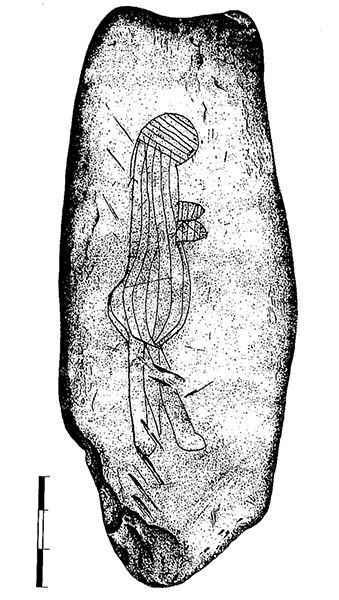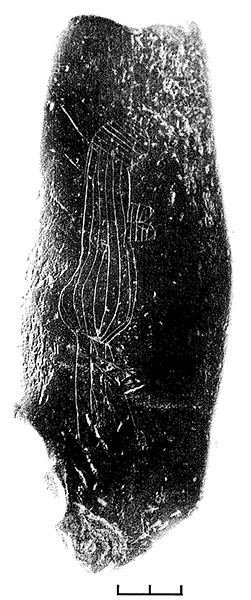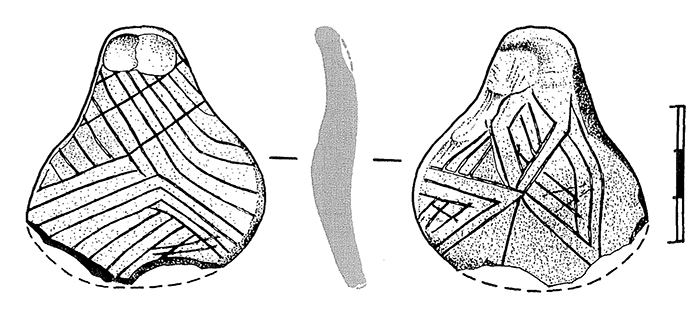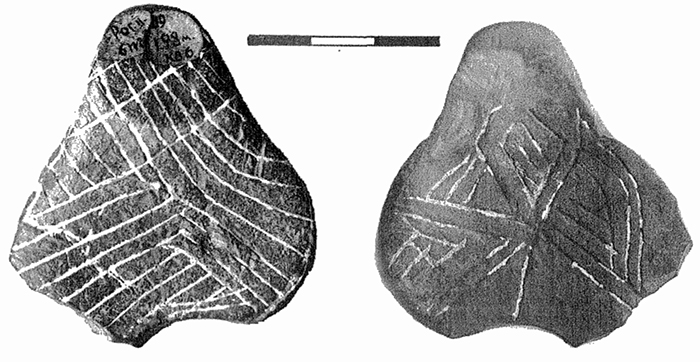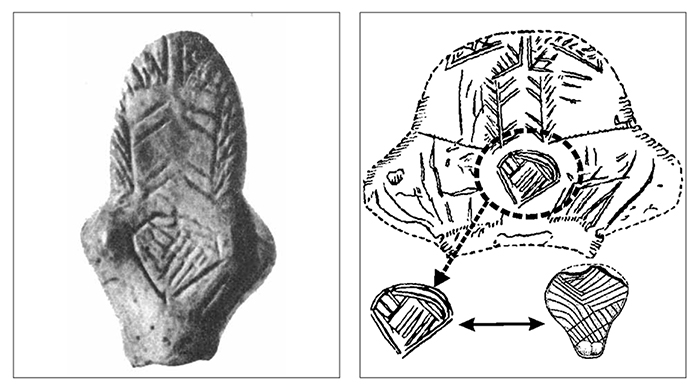Back to Don's Maps
Back to Venus figures from the Stone Age
The Rogalik Venus Figures
The images above from the site of Rogalik XI show a female figure engraved on a slate slab which has been used as a retoucher, from the late Palaeolithic, possibly around 13 000 BP.
Dimensions: 155 mm x 60 mm x 17 mm.
Note that the figure itself is ambiguous. It is in the shape of a penis, and if the breasts were not there, it would have been interpreted as male, with male genitalia between the legs. Note also that the head is very similar in terms of its overall shape, and the bindings or braided hair wrapped around it, to that of the Venus of Willendorf.
Photo and text: Gorelik (2005)
Additional comments in italics: Ralph Frenken and Don Hitchcock
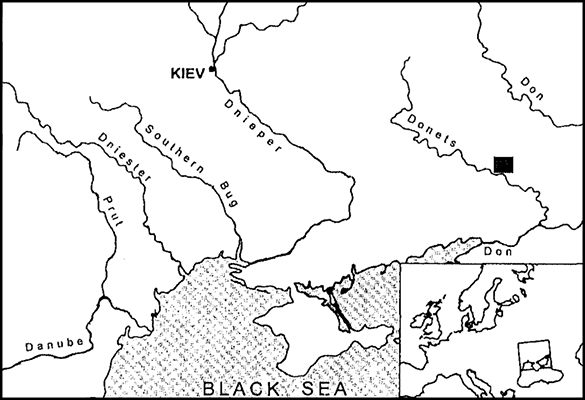
Location of Rogalik, and the regional setting of the Rogaliksko-Peredelskoye Final Palaeolithic sites.
Photo: Gorelik (2005)
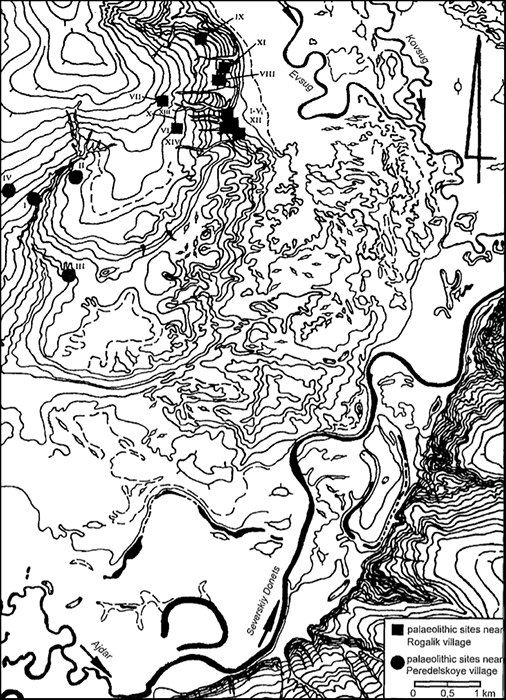
Topographical map of the Rogaliksko-Peredelskoye region with the distribution of Final Palaeolirhic archaeological sires.
Photo: Gorelik (2005)
Rogalik XI (VIIIa),Text above: Gorelik (2005)
( the site at which the engraved retoucher was found - Don )
The site is located about 700-800m from Rogalik II, on a terrace some 40m above the Evsug river. The cultural layer has been completely destroyed and redeposited by fluvial processes and ploughing. The bulk of the flint artefacts was collected on the ploughed surface, shortly after a slate retoucher engraved with a depiction of a female figure was found by N. I. Tarasenko
The following information was considered when establishing the authenticity of the engraving. Firstly, the retoucher was made of slate - a raw material typically used to produce similar implements in other Palaeolithic assemblages in the Rogaliksko-Peredelskoye region. Secondly, wear-trace analyses undertaken by A. K. Filippov showed that the find had been used later as a retoucher. Thirdly, a strong patination was observed in the furrows produced by engraving demonstrating the ancient age of the find.
This retoucher is made of a flat plaquette of sub-rectangular shape, measuring 155 mm x 60 mm x 17 mm. One side of the plaquette bears traces of intensive wear, which appear as dots, small holes and scratches. Areas of intensive utilisation are distributed along the edges, and on one of the ends of the artefact. There are also traces of recent (plough) damage on the surface. The female engraving is located along the central axis of the side of the plaquette which was exploited later as a retoucher. The silhouette of a slender, upright female is depicted in profile and facing left.
All parts of the body have been depicted, although somewhat generalised in proportion. The globe-shaped head and strongly protruding face without any details project slightly forward. Its contour is distinguished by a hatched filling made of seven diagonally placed, parallel lines. The neck and hands are not shown. The trunk is narrow, somewhat oblong, of cylindrical form with small, protruding breasts. The breasts are depicted two-dimensionally and are engraved with 5-6 vertical, parallel lines. The trunk merges into the rounded bulge at the bottom of the belly.
The navel and pubic triangle are not depicted. The line of the back is accentuated by the protruding buttocks and has 5-7 engraved vertical lines running from the oblique hatching of the head to the bottom. These lines emphasise the silhouette of the figure, giving the impression of a voluminous figure. The legs are thin and straight, with no hatching. The feet are short and round. In general, the legs are somewhat shorter than the trunk. The left leg is placed to the front, and a depiction between the legs, damaged by ploughing activities, can be discerned. The latter could be interpreted in different ways; either as a first, unsuccessful attempt to carve the left leg or - less likely - as the silhouette of a tail.
The relief of the image is variable. For example, the back of the figure is strongly emphasised, and in places traces could be observed where the burin had slid down or had skidded towards the outlined borders of the depiction.
The Rogalik female engraving can be attributed to the 'realistic' or 'natural' type, according to Delparte's classification of the Magdalenian style (Delporte 1993) , or to artistically stylised figures called plot forms in Russian, these being figures dedicated to specific themes. This is the first female engraving known from the Final Palaeolithic of Eastern Europe. The engraving is stylistically very close to Final Palaeolithic engravings found in the rest of Europe.
At the same time, the female engraving from Rogalik shows many traits comparable to the so-called Gönnersdorf type of female images, typical of Western and Central Europe. These features are manifested both in the posture of the figure and in the method of artistic realisation. The vertical posture of the Rogalik female carving, with a head and straight legs, contrasts with depictions of Gönnersdorf females, which are characterised by lack of head, a lordosis posture with knees partially bent, upraised rumps, back leaning forward and hanging breasts. Artistically, the engraving of the Rogalik female is distinguished by a wide usage of hatching, and lines which duplicate the silhouette.
The hatching could have been used to distinguish parts of the human body: head, breasts, trunk, and legs. The hatching on the head might symbolise a head dress, the hair-style or a mask. The hatching of the trunk might serve to represent the material from which the figure was made, lends volume and possibly symbolised the dress.
It is notable that in many cases there are groups of seven engraved lines - a number which appears to have been significant in Palaeolithic symbolism, and may have played a sacral role. Several similar examples are known in Palaeolithic art. One of these is the use of duplicate lines inside a silhouette in the famous stylised drawing on a mammoth tusk from Predmosti.
Horizontal or vertical hatching was used to fill some of the female engravings on slate retouchers from Gönnersdorf. H. Delporte mentioned the use of oblique hatching on the head of a female engraved on a stone retoucher from La Madeleine, which was published by L. Capitan and D. Peyrony (Delporte 1993).
Two-dimensional representations of parts of the human body, for example breasts and legs, are highly typical of Palaeolithic art. The method in which the breasts are portrayed in the Rogalik engraving has parallels in some depictions from Gonnersdorf, Pech-Merle, and in prehistoric African art (rock paintings of South Africa). If the feature between the legs is interpreted as the remains of an unsuccessful attempt to engrave a second leg, this could indicate that the Palaeolithic artist had a problem with the stability of the figure. This problem was solved by depicting the figure stepping forward on the left leg, in a similar manner to Greek and ancient Egyptian sculptures.
There are some features in the Rogalik engraving which resemble older objects of Palaeolithic art from the Gravettian period. These are the general modelling of the head, as seen, for example, on the famous Gravettian Palaeolithic figurines, and the vertical posture of the figure, which is characteristic of some Late Palaeolithic engravings, for example from Grotta Romanelli or Termo Pialat.
Final Palaeolithic mobiliary art object from Rogalik IIa.
Photo and text: Gorelik (2005)
Rogalik II AText above: Gorelik (2005)
This is one of four individual, neighbouring concentrations, situated on the central part of the slope of the main right bank of the Evsug river, close to Rogalik (Petrovka) village. The site is located on the surface of the left side of the Jakimovskaya ravine, which transects the main bank of the river.
This rather dense concentration of cultural debris, which ranges in size from 7-10 x 16-18 m, was investigated by an excavation covering an area of 232 m2• The thickness of the cultural layer was 15 - 25 cm. In general, two structural elements could be identified in the concentration: in the centre a kitchen zone with flint tools associated with a great number of fractured bones, mainly of horse, and around the periphery areas of flint knapping activities. The statuette made of limonite was recovered from the centre of the concentration at the base of the cultural layer, which mainly consisted of flint artefacts and fractured animal bones. The statuette was deposited in a horizontal position, with buttocks uppermost. Both sides of the figurine are covered by a thick layer of calcrete.
The statuette was formed without producing significant changes to the flat surface of the pebble, especially along the lateral sides and the back. However, deliberate traces of modification were confirmed during a microscopic investigation of the find, undertaken by E. Girya in the Experimental-Trassological Laboratory of the Institute of the Material Culture History of the Russian Academy of Sciences (St. Petersburg). Traces of abrasion on one of the lateral sides indicate the formation of the symmetrical contours of the figurine's waist. The wide, flat surface of the negatives which form the back of the statuette on the opposing lateral side, gives the figurine its characteristic sub-triangular relief. Supplementary modifications of the natural form of the pebble have produced a highly stylised female statuette with wide, accentuated hips, with the buttocks jutting out in profile.
The figurine has the following dimensions: height 57 mm; depth 6 mm; width at the top 19 mm; width at the bottom 51 mm. It shows traces of ancient damage. The lower part - probably rounded originally - is now broken into two pieces. At the top on the front of the figurine there are two cavities where the stone has weathered away. Both sides of the figurine are covered by incised, multilinear zigzags (herring bone motif).
Both sides of the statuette are decorated by a repetitive pattern. Beginning at the centre of the figurine, the surface is divided into a number of sectors filled with chevrons or rhomboids. The front of the statuette is decorated by a panel of chevrons enclosed by an engraved line which follows the outline of the figure. This line is absent on the back. The pattern described above is further marked by three oblique, parallel lines - running from left to right and from bottom to top - at the top of the front of the statuette. In general, the ornamental field on the front is subdivided into three sectors of different angles: 85°, 120°, and 155°.
On the back there are three sectors filled with chevrons formed by duplicate lines at acute angles (40° - 60°), along with two other sectors filled with rhomboids. The panel of one chevron is filled by three transverse, parallel lines. The second is cut by a single long axis, and the third is filled by a rhomboid with an X-shaped incision inside. Two parallel lines are engraved inside in one of the rhomboids, the other is covered by hatched lines.
The Rogalik II A statuette has no direct comparisons in Palaeolithic mobiliary art. It could be con- sidered to belong to the so-called category of 'conventional' female images or fit into the general frame of the Magdalenian style, characteristic for the end of the Palaeolithic. From my point of view, if both the general modelling of the figure and the decoration of the find are taken into consideration, the closest analogy would be part of a short female statuette (Shovkoplas 1965, pl. 59) from the collection of the famous Late Palaeolithic site of Mezin (North Ukraine).
( note that Gorelik refers to this object as a statuette, a figurine, and a female image. Vetrov (2007) says that 'A proper criticism of this interpretation has already been done by G.P. Grigorev (Grigoriev G.P. 2004), and Vetrov (2007) goes on to describe it as a triangular symbol of a female' - Don )
Modern investigators of Palaeolithic art interpret the chevron decoration on anthropomorphic female figurines as a depiction of female genitalia. The geometric pattern of the Rogalik II A statuette is reminiscent of patterns of decoration found on Azilian pebbles. Keeping in mind the chronology of the statuette, it could be considered as an intermediate link between voluminous and flat Palaeolithic sculptures and engraved Azilian pebbles.
Vetrov (2007) points out that the decorations on the plate at Rogalik-2A are analogous with those of the statuette from the site at Mezin (as above), as basic elements coincide.
First of all, its outline coincides with a triangle there that has a rounded top side. Besides this, there is a coincidence in the orientation of basic elements of the internal shading. In both cases from the left top corner of a triangle the lines have been drawn from left to right and from the top-down, and under the top party of a triangle the lines are horizontal; from the right top corner of a triangle the lines have been drown from right to left and from the top-down. As to discrepancies of individual details, it is necessary to take into account a technological difference between cutting lines on the firm surface of the statuette made of mammoth’s tusk of the site at Mezin and cutting lines on the rather soft plate from the site at Rogalik-2A.
We suggest that the triangular symbol analysed by us is a female symbolic.
Photo and text: Vetrov (2007)
References
- Delporte H., 1993: L'image de la femme dans l'art préhistorique, Paris.
- Gorelik A., 2005: On the characteristics of the final Palaeolithic mobiliary art of the South-Eastern Ukraine: Certain aspects of the investigations of the Rogaliksko-peredelskoye regional site complex, Archaologisches Korrespondenzblatt, 35(3):283-300 January 2005
- Gorelik A., 2005: On the characteristics of the final Palaeolithic mobiliary art of the South-Eastern Ukraine: Certain aspects of the investigations of the Rogaliksko-peredelskoye regional site complex, Archaologisches Korrespondenzblatt, 35(3):283-300 January 2005
- Григорьев Г.П., 2004: Рецензия на А.Ф. Горелик. 'Памятники Рогаликско-передельского района. Проблемы финального палеолита Юго-Восточной Украины', Киев-Луганск, 2001. 366 с., Российская археология, 2004 - No2. – С. 181-182.
- Grigoriev G.P., 2004: Review of A.F. Gorelik. "Monuments of the Rogalik-Peredelsky area. Problems of the Final Paleolithic of South-Eastern Ukraine". Kyiv-Lugansk, 2001. 366 с., Russian Archaeology, 2004. - No2. - С. 181-182.
- Kitagawa, K. et al., 2018: Glacial and post-glacial adaptations of hunter-gatherers: investigating the late Upper Paleolithic and Mesolithic subsistence strategies in the southern steppe of Eastern Europe, Quaternary International, 465, 192-209. https://doi.org/10.1016/j.quaint.2017.01.005
- Vetrov, V., 2007: The Late Paleolithic Art of the steppes in the Northern Black Seaside and the Sea of Azov Side, Valcamonica Symposium, 20072017.01.005
